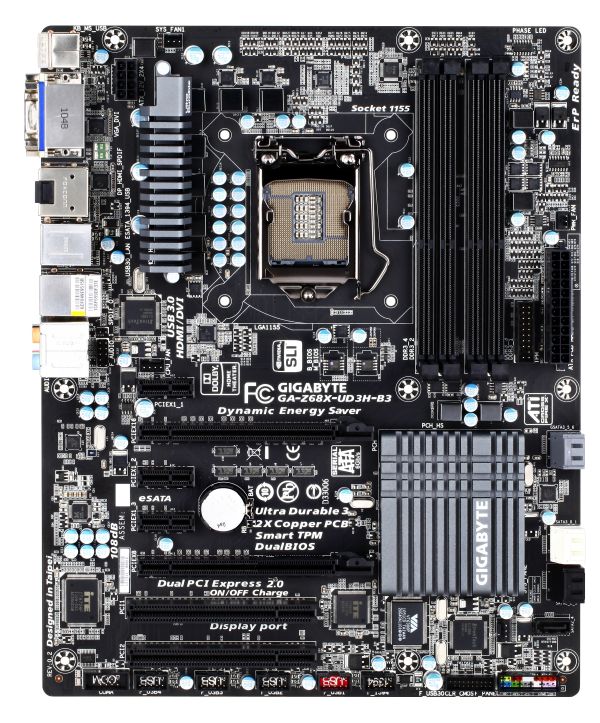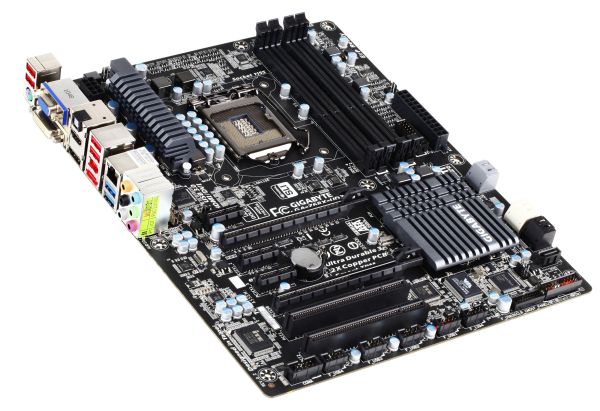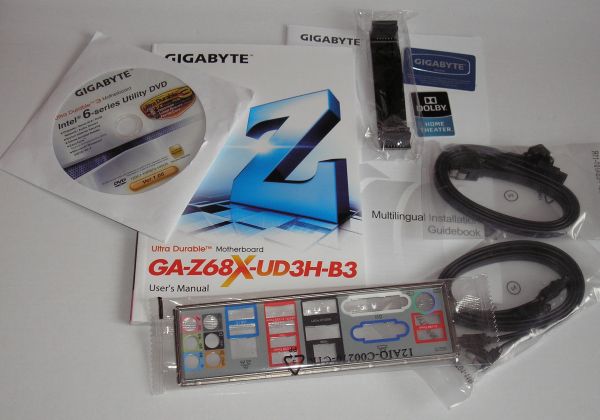Gigabyte Z68X-UD3H-B3 Review
by Brendan van Varik on July 11, 2011 7:01 AM EST- Posted in
- Gigabyte
- Motherboards
- Sandy Bridge
- Z68
Gigabyte has released their Z68 lineup, and today I am going to look at the UD3H - a $170 Z68 board aimed at the mainstream consumer market. The Z68 based motherboards are very similar to the P67 equivalent but they have had a few extra features added. They include Virtu and SSD caching as well as allowing you to take advantage of the GPU built into your Sandy Bridge processor. Is it worth switching from P67 to Z68 for a few extra features? Well, after what I have seen, no, not really.
Visual Inspection
Just like most of Gigabyte's latest range, they have gone with the black and gray theme for this motherboard. In my eyes, it looks very classy and professional.
Gigabyte engineers have used their heads when it comes to the PCIe layout. There’s plenty of room for dual GPU configurations and there’s even a slot for breathing space when utilizing dual slot GPUs. From top to bottom, we have a PCIe 1x, 16x, 1x, 1x, another 16x and two PCI slots. When two GPUs are used, the PCIe 16x lanes run at 8x/8x.
As the PCH heatsink is small and passive, so if dual GPUs are utilized, there may be a heat conductance issue on to the heatsink if there is a lack of airflow. Some aftermarket graphics card coolers vent hot air into the case which will also cause the PCH to warm up if the chassis isn’t vented properly. In fact, when the board was put through its paces on the test bed, the PCH heatsink got very warm to the touch if there was no fan pointed at it.
There is a regular looking I/O panel. The picture above details the selection of connectivity options at the back of this motherboard. A PS/2 port which can be used for either a keyboard or a mouse but not both at the same time. There are a total of four USB 2 and two USB 3 ports, an eSATA 3Gb/s port as well as a FireWire port. The display ports include DVI, VGA, HDMI and a display port. The HDMI and DisplayPort connections carry audio. The single Ethernet port is controlled by the Realtek RTL8111E chip. You can use either the SPDIF or the typical audio connections for your sound.
With regards to the SATA connections, we have three (internal) SATA 3Gb/s connections and four SATA 6Gb/s ports. There is an eSATA port on the I/O of the motherboard which takes the total of SATA 3Gb/s ports to four. Two of the four SATA 6Gb/s ports are controlled by a separate controller – a Marvell 88SE917. These are colored gray and have support for RAID 0 and 1. The rest of the SATA ports are controlled by the Intel Z68 chipset and allow for RAID 0, 1, 5 and 10. You are able to create a RAID array across the SATA 3Gb/s and 6Gb/s ports although the performance may vary (according to Gigabyte).
After comparing to other motherboards, the SATA layout is a tad odd. On most motherboards, you would typically find a row of SATA connectors that are adjacent to each other and then color-coded accordingly. Even though it is only one port which points out of the board and the rest stick out of the side, it looks odd and it doesn’t make sense why this has been done.
A total of four fan headers can be used on this motherboard. There is one for the CPU cooler and three for chassis fans. The CPU fan header is not located in a familiar position as you’d find with other motherboards - it’s in the center board just above the PCIe 1x slot. The two system fans are on opposite sides of the board - one is located just above the VRM heat sink and the other is located just below the PCH heat sink. It would have made more sense to use the header located above the VRM heat sink as the CPU header and vice versa. The PWR fan header is located just above the 24pin power which just like SYS_FAN1 does not allow for speed control.
What is included in the box?
A user’s manual and a multilingual guidebook.
- Driver and utilities DVD
- 2x SATA 6Gb/s cables
- 2x SATA 3Gb/s cables
- A SLi bridge
- I/O shield
- 1x Gigabyte case sticker
- 1x DOLBY case sticker
You do not get many extras with this motherboard. In fact, it is pretty minimalist. Just like other manufacturers, Gigabyte have included the essentials to get your system up and running, and nothing more. If you want more accessories such as the 3.5” front panel with two USB 3.0/2.0 ports or a SATA bracket, you will have to buy the more expensive, higher end models.















70 Comments
View All Comments
Mr Perfect - Tuesday, July 12, 2011 - link
Of course we can do that, but it's time for the industry to move on. Actually, the rest of the industry has moved on. It's just Gigabyte dragging their feet. Put new features on your new boards, or we'll find someone who does!Lord 666 - Monday, July 11, 2011 - link
In the immediate need to build a multi-purpose lab and either this board or the UD4 (need x4 pcie for raid card) are contenders. Other than maybe putting an intel NIC on it, will it work with esxi 4.1?My googling has not found anything conclusive and I trust Anandtech.com before any hack out there.
Taft12 - Tuesday, July 12, 2011 - link
I wouldn't count on support for a bleeding-edge consumer-grade chipset. You're asking for trouble. Google hasn't found anything because nobody has tried it yet.-=Hulk=- - Monday, July 11, 2011 - link
Do you find that smart to use an overdimensioned 1250W PS to measure the power consumption???At max 106W consumption your PSU is only used at less than 10W. At ilde it's even worse. The problem is that under 15% load the PSU has an horrible efficiency even a Gold rated one, why spent so much money if a low power bronze PSU works better in such a power range....
Your power consumption numbers are nothing worse, sorry, and promoting sure overdimensed power supply doesn't help the final consumer because manufacturers don't develop low power PSU, there aren't enough available (under 250-300W Gold) on the market, because site like anandtech promote the "the bigger than better", that's totally stupid especially since our CPU consumes less.
IanCutress - Monday, July 11, 2011 - link
We understand this - it's not an oversight on our part. In order to be consistent through reviews, we like to keep the PSU constant - even when it comes to testing Fusion boards or triple SLI, a comparison between them for readers is always good. With completely different power supplies, no comparison between the numbers could be justified. There's also the fact that we don't have access to a mountain of PSUs available (actually, Brendan had a couple die on him during this review alone and had to keep redoing tests until one worked the whole way through) to test a system with a PSU which has its peak efficiency in this area, which again merits the comment above about providing comparable and meaningful power reading comparisons.JWatson - Monday, July 11, 2011 - link
I got this motherboard a couple of days ago for $130 with a $180 i5-2500k at Microcenter during their $40 off any 1155 motherboard CPU combo deal. So far it's been a great motherboard. I haven't really tried overclocking that much, other than setting the multiplier to 42 to get 4.2ghz but it's been very stable with no issues running prime 95 for several hours. I tried getting it to 4.3ghz using stock voltage but it would crash, so I went back to 4.2 and called it a day.The only issue I've come across was after I installed an Intel 320 120GB SSD. For some reason it would hang at the "Loading Operating System" screen. For whatever reason, in your BIOS, you may want to change the First Boot device to Hard Drive, otherwise it will hang there for a while. If you set the First Boot device to a DVD drive, make sure it has the name of the Device, like "BenQ 20x" instead of "CDROM" otherwise it might hang again. However, once that was changed, the issue stopped.
Another word of advice, don't "Install ALL" from the Gigabyte DVD Driver CD. It will install a bunch of crap you don't want, so install the drivers you need individually.
All in all, for 130 bucks, it's a great board for those that want to do mild overclocking and get a bunch of features for a fantastic price.
PrinceGaz - Monday, July 11, 2011 - link
In the specifications:"1x D-Sub port
1x DVI-D port, supporting a maximum resolution of 1920x1200
*The DVI-D port does not support D-Sub connection by adapter.
1x HDMI port, supporting a maximum resolution of 1920x1200
1x DisplayPort, supporting a maximum resolution of 2560x1600p"
By definition, DVI-D is digital only and cannot support the analogue D-Sub with an adapter (it would have to be DVI-I or the rarely seen DVI-A to support an analogue connection). Besides, as the board has a D-Sub port anyway, why would you use an adapter as it can only degrade the quality? (except the unlikely scenario these days where you are using a monitor with only an analogue input and have only a DVI to D-Sub cable available to connect it with).
Vhozard - Monday, July 11, 2011 - link
Congratz Brendan, awesome article.Couldn't find any mistakes :P
BernardP - Monday, July 11, 2011 - link
Could someone point me to a Gigabyte Z68 mobo that comes with 3.5” front panel USB 3.0 adapter? I couldn't find any on the Gigabyte web site.The only one I can find is a P67 model from Asus: P8P67 Deluxe.
With so few cases coming with the required dual front USB 3.0 connectors plus the cable and motherboard plug, the front panel 3.0 adapter is a big plus.
gevorg - Monday, July 11, 2011 - link
I have this board and its too noisy even at idle since it runs the case fans at near full speed. No way to adjust them in BIOS. Had Intel P67 board with the exact same config/components, and it was silent at idle. It sucks that reviews like these focus primary on price/performance and ignore other important factors.P.S. The non-graphic BIOS is just fine, pretty straight forward, its not like you access BIOS every day.